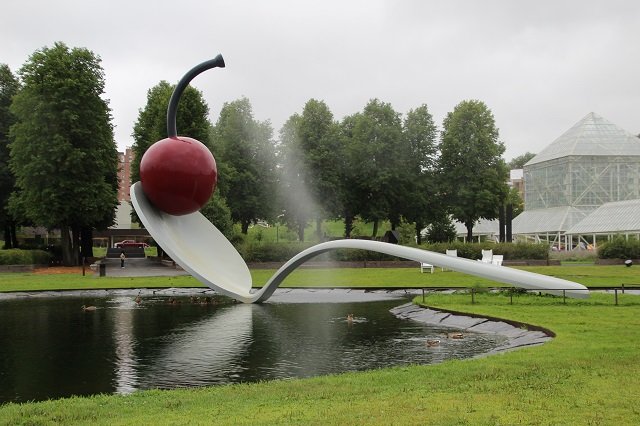The Minneapolis Sculpture Garden was one thing on our Mid-West Adventures through IA, MN, and NE trip. It is one of the largest urban sculpture gardens in the country, with 40 permanent art installations and several other temporary pieces that are moved in and out periodically. The centerpiece of this 11-acre (4.5 ha) garden is the famous Spoonbridge and Cherry (1985–1988) fountain designed by husband and wife Claes Oldenburg and Coosje van Bruggen. For those you want to visit, the garden is located near the Walker Art Center, which operates it in coordination with the Minneapolis Park and Recreation Board. The land was originally purchased by the park board around the start of the 20th century, and became known as “The Parade”. This was due to the fact that it was used for military drills, and later became known as the Armory Gardens after park superintendent Theodore Wirth created a formal design that included a U.S. National Guard armory (Kenwood Armory) for Spanish War volunteers.
Later the area became a civic and cultural center until 1913 when a floral convention transformed the land into floral gardens, which it remained for the next 50 years. In 1988, the Minneapolis Sculpture Garden, designed by Edward Larrabee Barnes and landscape architects Quinnel and Rothschild, officially opened. Since its opening, the Garden has welcomed millions of visitors, showcasing works from the Walker Art Center’s renowned collections of modern and contemporary art. We had an amazing time running around checking out a lot of the pieces of art. Sadly it rained a lot while we were there, but we got as many pictures was we could. Here are some pictures as well as descriptions per the Walter Art Center. These are in no paticular order. Enjoy.
Amaryllis by Tony Smith
Tony Smith worked as an apprentice to architect Frank Lloyd Wright and was a practicing architect, designer, and painter for 20 years before turning to sculpture around 1960. Creating his monochromatic works in steel using simple geometric forms, Smith influenced the development of Minimalist sculpture, which values rational order, conceptual rigor, and clarity over expressive values and content. This sculpture, composed of two polyhedron shapes, appears to change dramatically when viewed from different angles. From one perspective, the two pieces appear identical and balanced; from another, the entire structure seems ready to topple. Smith titled the work Amaryllis because at first it looked rather ungainly, reminding him of the flowering plant with its bold, top-heavy blooms.
Five Plates, Two Poles by Richard Serra
The straightforward title of Richard Serra’s work describes its construction: two poles along the ground prop up five large, flat plates of heavy steel. These elements seem to be precariously balanced, but they are in fact engineered to be perfectly stable. Exploring the properties of mass and gravity, Serra’s complex composition of ordinary, industrial materials creates a dynamic interplay of line, space, and silhouette. The artist has been investigating these scientific principles in his art since the late 1960s, often constructing pieces on a monumental scale. When placed in an outdoor setting, his sculptures highlight the contrasts between the rigid shapes and the natural world beyond.
Hahn/Cock by Katharina Fritsch
Towering nearly 25 feet over the Minneapolis Sculpture Garden, Katharina Fritsch’s blue rooster is at once lifelike and completely unreal. Animals and everyday objects have long been subjects for the artist, who makes them otherworldly and extraordinary through bold shifts in scale, color, and material. The rooster can be a symbol of pride, power, and courage or posturing and macho prowess. Fritsch has admitted that she enjoys “games with language,” and the sculpture’s tongue-in-cheek title knowingly plays on its double meaning. Like Spoonbridge and Cherry, Hahn/Cock presents an unexpected take on the idea of a traditional public monument. Together, these two landmarks show how ordinary objects can become iconic and deeply symbolic.
Arikidea by Mark di Suvero
Though monumental, Mark di Suvero’s Arikidea is composed with surprising delicacy. The gigantic steel beams have been carefully and safely balanced, so a simple touch or a passing breeze will cause its elements to sway. A wooden swing suspended from the center playfully invites us to interact with the sculpture. The work’s title comes from the word “arachnid,” or spider—a creature admired by the artist for its ability to create complex, three-dimensional structures. When di Suvero began making sculptures in the late 1950s, he was drawn to “non-art” materials such as old tires, scrap metal, and steel girders. He assembled these into unexpected combinations, leading to the massive outdoor works he is known for today.
Empire by Eva Rothschild
Eva Rothschild often uses geometric forms and industrial materials in her art, creating large-scale works that appear both delicate and strong. The mammoth archway of Empire meets the ground at 10 different points, encouraging us to not only look at the sculpture from afar but also to experience the space around, beneath, and between its spindly forms, which evoke branches or “legs.” The title Empire suggests a great power, its vast reach enabled by its canopy-like silhouette. This is one of several new works in the Minneapolis Sculpture Garden by a younger generation of artists exploring abstract forms. Empire is Rothschild’s first permanent outdoor work in the United States.
Woodrow by Deborah Butterfield
Under the expansive Montana sky, Deborah Butterfield has been making art since the 1970s inspired by the horses on her ranch. Her works are often constructed with found materials such as wood, scrap metal, or straw. While Woodrow, her first outdoor sculpture, appears to be made of branches, it is actually metal in order to better with- stands the elements. To create the sculpture, Butterfield collected sticks and bark, painstakingly cast each piece in bronze, then reassembled and welded them together to form the horse’s body. The sculpture was then given a surface treatment, or patina, to mimic the color of the original sticks. The meticulous result—known as trompe l’oeil, or “trick of the eye”—gives Woodrow its convincing woodlike appearance.
The Spinner by Alexander Calder
In 1931 Alexander Calder made his first truly kinetic sculpture—a construction of carefully balanced elements that could rotate solely by currents of air or wind. This subtle movement created a constantly changing effect. The artist created many versions of these, some suspended from the ceiling, while others were designed to be outdoors, such as this work. They became known as “mobiles,” and gave form to an entirely new type of art. The Spinner, which graces the Minneapolis Sculpture Garden’s west entrance, combines a range of the brightly painted abstract forms for which Calder was known. The sculpture twists like a weather vane with changes in the wind.
Love by Robert Indiana
In the late 1950s, Robert Indiana began making paintings and sculptures that featured words as the main visual subject. He has long been drawn to single, poetically powerful words, such as “EAT,” “DIE,” and his most famous, “LOVE.” Here, the artist has stacked the letters in a grid, assembling them, as he stated in 1969, “as compactly and economically as possible.” Indiana’s LOVE, with its tilted “O,” has been made in many variations, from a postage stamp to gargantuan versions in brightly painted steel. It is now the artist’s most iconic image, one that has had broad resonance across cultures and generations, from the 1960s to today.
Spoonbridge and Cherry by Claes Oldenburg and Coosje van Bruggen
A giant ice cream cone, a huge electric plug, an enormous bag of French fries—with his surprising representations of everyday things, Claes Oldenburg became a key voice in Pop Art, a 1960s movement that saw many artists turning to advertising and consumer products for subject matter. By the early 1980s, he had begun to make monumental outdoor works with Coosje van Bruggen, his wife and artistic partner. Spoonbridge and Cherry is one of their most celebrated collaborations. It was the first work commissioned for the Minneapolis Sculpture Garden, which opened in 1988.
The fountain-sculpture was inspired by a novelty item Oldenburg had collected in 1962, featuring a spoon resting on an “island” of plastic chocolate. From this, the artists envisioned a gigantic utensil as a fanciful bridge over a pond. In considering Minnesota as a site, they compared the spoon’s raised bowl to the prow of a Viking ship or a duck bobbing in a lake. Van Bruggen added the cherry, a personal symbol recalling happy moments in a childhood clouded by World War II. At more than 50 feet long, Spoonbridge and Cherry has delighted visitors ever since and is now a familiar and iconic symbol for the Twin Cities.
Like I said it was a rainy day while we were checking out the Minneapolis Sculpture Garden, but we still had an amazing time checking out all the sculptures. Of course, the Spoonbridge and Cherry was the main sculpture we wanted to see and brought us to the garden, but I was quite surprised at the uniqueness of each piece. Here is a link to their website again if you want to read more about the history of the park. If you have been, please share yuor experience as well as your favorite sculpture. Happy travels!
Minneapolis Sculpture Garden Visitor Information
The Minneapolis Sculpture Garden is free, open to the public, and is open from 6 am to 12 midnight every day.
Directions and Parking
725 Vineland Place, Minneapolis, MN 55403
Paid underground parking is available on-site. Enter the ramp on Vineland Place at Bryant Avenue.
Accessible parking in the underground ramp is designated near the elevator and entrance.
Metered on-street parking is available on the surrounding streets.
Bike racks are located by the main entrance on Vineland Place and on the corner of Groveland Terrace and Hennepin Avenue.
Metro Transit bus lines are 4, 6, 12 & 25.


















2 thoughts on “Minneapolis Sculpture Garden – Minneapolis, Minnesota”